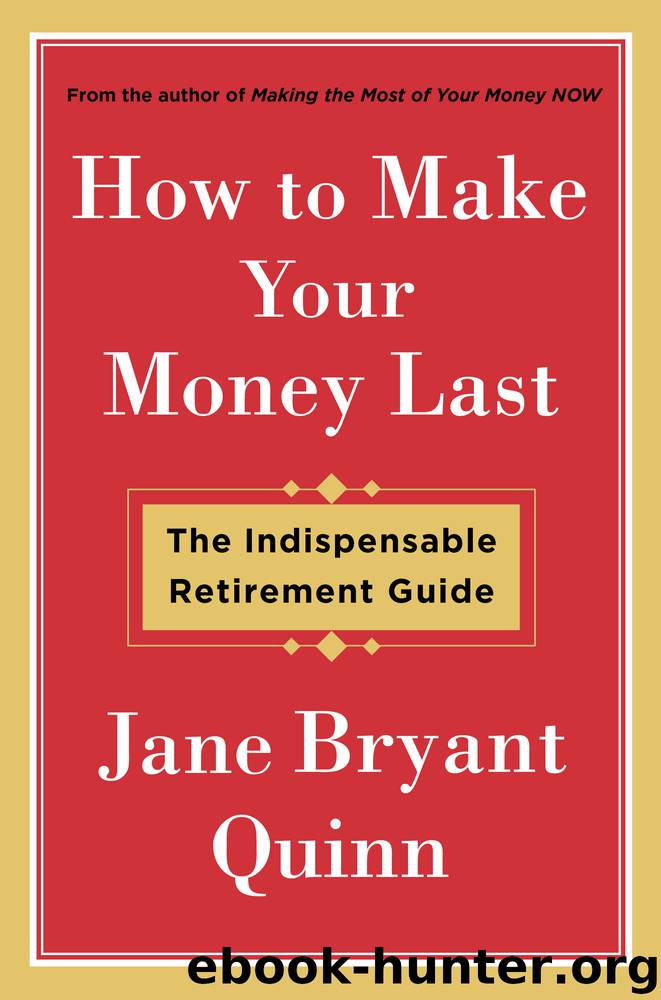How to Make Your Money Last by Jane Bryant Quinn

Author:Jane Bryant Quinn
Language: eng
Format: epub
Publisher: Simon & Schuster
WHEN YOU’RE TAKING MONEY FROM SAVINGS TO PAY YOUR BILLS, WHICH TYPE OF ACCOUNT SHOULD YOU TAP FIRST?
Retirees have many possible sources of income: Social Security, taxable savings and investment accounts, tax-deferred retirement accounts such as traditional IRAs, and Roth IRAs that grow tax free. The more tax-efficiently you use your money, the longer your nest egg will last. Here are some general rules on which accounts to tap first:
• Normally, spend taxable savings before dipping into a traditional IRA or similar account. “Taxable savings” means money that’s not held in a tax-deferred or tax-free retirement account.
• There are a couple of times when you should tap a traditional IRA first, before using taxable savings. For example: (1) You’re in a low tax bracket and your heirs are in a high one. The IRA money is worth more if you take it now. (2) You want to shrink your IRA so that, when you reach 70½, the required withdrawals won’t be as large. That might save you from paying a higher tax on your Social Security benefits when IRA withdrawals start (see page 71).
• If you’re in the low, 15-percent tax bracket, you might decide to withdraw extra money from your IRA, even if you don’t need it now. Take it from the stock funds you own and reinvest it in stock funds in your taxable account. From this point on, you’ll get the low capital gains rate on their increase in value.
• Spend taxable and tax-deferred savings if that helps you put off taking Social Security until you reach 70, if you’re single, or perhaps 66 to 70 if you’re married. At older ages, you will get the highest possible individual or family benefits for life (see pages 42 and 54). If you take benefits earlier you will get less.
• Normally, tap a traditional IRA before tapping a Roth. The longer the Roth can grow tax free the better. But tap the Roth first if you’re in a particularly high tax bracket and expect your bracket to drop in future years.
• If you have both a taxable and a tax-deferred account for long-term investments, stuff the taxable account with stocks. That way, any profits will be taxed at the low rate for capital gains. All your taxable bonds, such as Treasury funds, go into the tax-deferred account. Interest income is taxed at ordinary income rates no matter where the bonds are held.
Download
This site does not store any files on its server. We only index and link to content provided by other sites. Please contact the content providers to delete copyright contents if any and email us, we'll remove relevant links or contents immediately.
| Analysis & Strategy | Bonds |
| Commodities | Derivatives |
| Futures | Introduction |
| Mutual Funds | Online Trading |
| Options | Portfolio Management |
| Real Estate | Stocks |
Pioneering Portfolio Management by David F. Swensen(5629)
Rich Dad Poor Dad by Robert T. Kiyosaki(5184)
How To Win Friends and Influence People by Dale Carnegie(3796)
The Money Culture by Michael Lewis(3305)
The Dhandho Investor by Mohnish Pabrai(3186)
The Wisdom of Finance by Mihir Desai(3104)
Liar's Poker by Michael Lewis(2830)
The Intelligent Investor by Benjamin Graham Jason Zweig(2606)
The ONE Thing by Gary Keller(2542)
Mastering Bitcoin: Programming the Open Blockchain by Andreas M. Antonopoulos(2528)
Investing For Dummies by Eric Tyson(2483)
How to Day Trade for a Living: Tools, Tactics, Money Management, Discipline and Trading Psychology by Andrew Aziz(2472)
How to Win Friends and Influence People by Dale Carnegie(2456)
Rich Dad Poor Dad: What The Rich Teach Their Kids About Money - That The Poor And Middle Class Do Not! by Robert T. Kiyosaki(2446)
Fooled by Randomness: The Hidden Role of Chance in Life and in the Markets by Nassim Nicholas Taleb(2434)
Zero Hour by Harry S. Dent Jr. & Andrew Pancholi(2257)
Market Wizards by Jack D. Schwager(2177)
Rich Dad's Guide to Investing by Robert T. Kiyosaki(2125)
How to Pay Zero Taxes, 2018 by Jeff A. Schnepper(2117)
